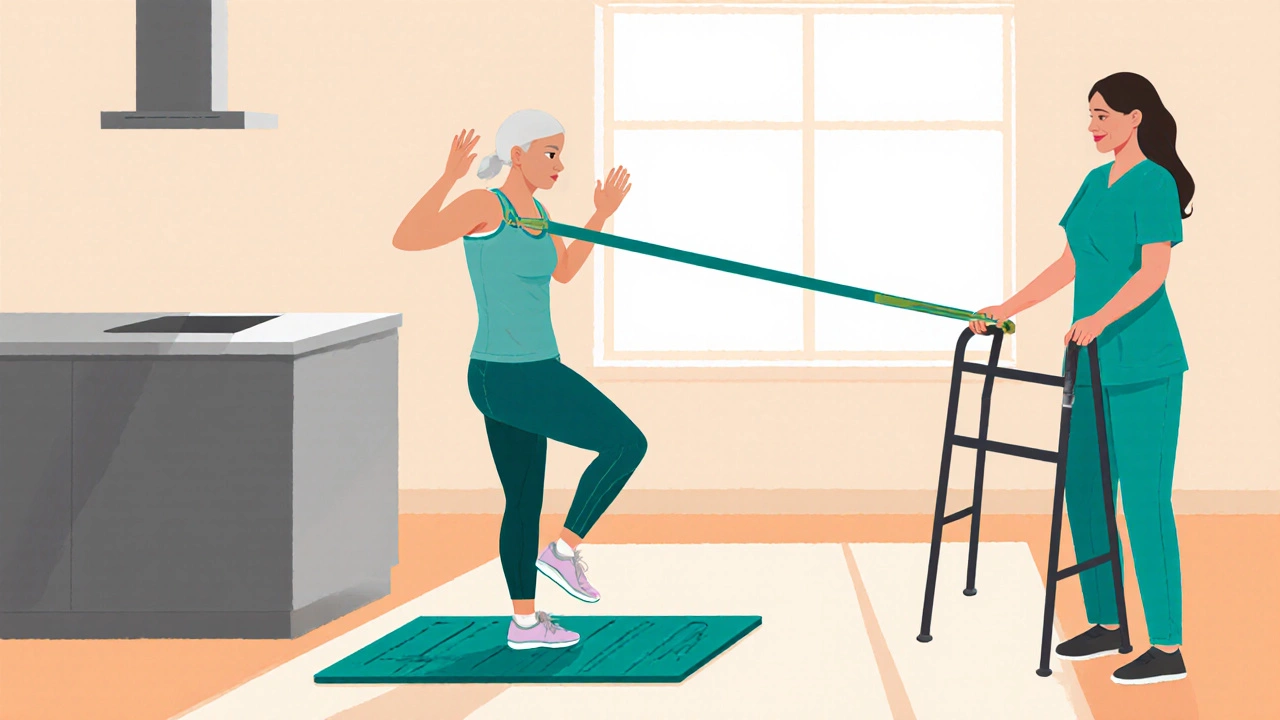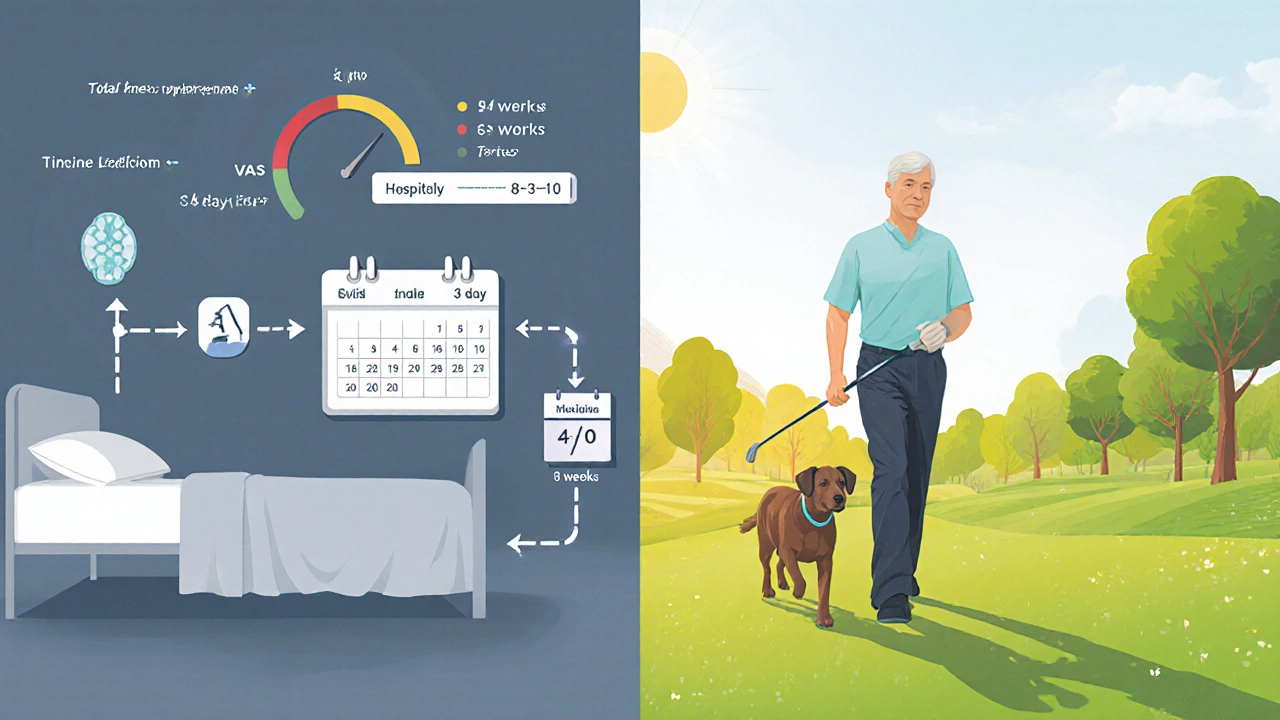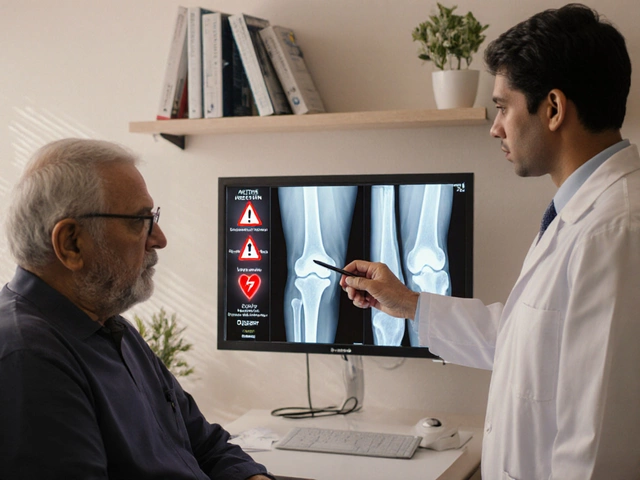Knee Replacement Recovery Time Calculator
Personalized Recovery Estimator
Enter your details to get a personalized estimate of your knee replacement recovery timeline.
Total knee replacement is a surgical procedure that swaps out a damaged knee joint for a prosthetic implant. If you or a loved one is facing this operation, the biggest question is usually: how long does it take to get back to normal life? Below you’ll find a step‑by‑step look at the typical recovery curve, the factors that can speed it up or slow it down, and practical tips to make the journey smoother.
Key Takeaways
- Most patients leave the hospital within 2-4 days after a full knee replacement.
- By six weeks, basic daily activities (walking, climbing stairs) are usually possible with pain control.
- Full functional recovery - running light errands, low‑impact sports, and near‑normal range of motion - often takes 3-6 months.
- Age, pre‑op fitness, surgical technique, and adherence to physical therapy are the biggest recovery influencers.
- Following a structured rehab plan and keeping complications like blood clots and infection at bay dramatically reduces setbacks.
What is a Full Knee Replacement?
A full knee replacement, also called a total knee arthroplasty (TKA), replaces the femoral, tibial, and often the patellar surfaces with metal and plastic components. The goal is to relieve pain from osteoarthritis, rheumatoid arthritis, or severe joint damage and to restore joint stability.
Typical Timeline from Surgery to Home
Recovery can be broken into clear phases. Each phase has its own milestones and common challenges.
Hospital Stay and Immediate Post‑Op Phase (Days 0‑2)
After anesthesia wears off, patients are moved to a recovery room for monitoring. Pain control usually involves a multimodal approach: nerve blocks, oral opioids, and non‑steroidal anti‑inflammatory drugs (NSAIDs). Early mobilization is critical - most surgeons get patients standing and taking a few steps within 12‑24 hours.
Key goals in this window:
- Control pain enough to start moving.
- Begin passive range‑of‑motion (ROM) exercises with a physical therapist.
- Start deep‑breathing and ankle pumps to prevent lung issues and blood clots.

Early Rehab (Weeks 1‑6)
Once home, the focus shifts to regaining motion and strength. A typical schedule looks like this:
- Weeks 1‑2: 3‑4 short walks daily, gentle heel slides, quadriceps sets, and ice for swelling. Expect to use a walker or crutches.
- Weeks 3‑4: Transition to a cane, increase walking distance to 15‑20 minutes, begin stationary bike with low resistance.
- Weeks 5‑6: Add closed‑chain exercises (mini‑squats, step‑ups) and partner‑assisted balance drills.
Most patients achieve 0‑90° of knee flexion by the end of week six, enough to climb stairs comfortably.
Mid‑Term Recovery (6‑12 Weeks)
Strength gains become noticeable. The implant is fully settled, and the risk of early complications drops sharply.
- Walking distances of 30‑45 minutes without pain.
- Full weight‑bearing without assistive devices for many individuals.
- Return to light household chores, low‑impact aerobics, and swimming.
Full Functional Recovery (3‑6 Months and Beyond)
By the three‑month mark, most patients report minimal pain and can drive, work a desk job, or resume golf. The final plateau - reaching 110‑120° of flexion and maximal quadriceps strength - usually occurs between four and six months.
Long‑term, the prosthetic knee can last 15‑20 years, provided the patient maintains a healthy weight and avoids high‑impact sports.

Factors That Speed Up or Slow Down Healing
Recovery isn’t one‑size‑fits‑all. Here are the top influencers:
- Age: Younger patients (<60) tend to regain strength faster.
- Pre‑op fitness: Those who exercised before surgery bounce back quicker.
- Surgical technique: Minimally invasive approaches often shorten hospital stay.
- Complications: Infection, blood clots, or stiffness add weeks or months.
- Adherence to therapy: Skipping PT sessions is the most common cause of delayed recovery.
Tips to Optimize Your Recovery
- Start a low‑impact exercise program (e.g., stationary bike) at least six weeks before surgery.
- Follow the prescribed pain‑medication schedule - don’t wait for pain to spike.
- Ice the knee for 20 minutes, three to four times a day to control swelling.
- Keep the incision clean and dry; watch for redness or drainage.
- Take prescribed blood‑clot prophylaxis (usually low‑dose aspirin) as directed.
- Stay hydrated and maintain a protein‑rich diet to support tissue repair.
- Set realistic milestones - celebrate small wins like walking 10 minutes pain‑free.
Comparison: Conventional vs. Minimally Invasive TKR Recovery
| Aspect | Conventional TKR | Minimally Invasive TKR |
|---|---|---|
| Hospital stay | 3‑4 days | 2‑3 days |
| First‑week pain (VAS score) | 6‑7/10 | 4‑5/10 |
| Time to 90° flexion | 6‑8 weeks | 4‑6 weeks |
| Return to light work | 8‑10 weeks | 6‑8 weeks |
| Overall complication rate | ~5% | ~3% |
Both techniques aim for the same long‑term outcome, but the minimally invasive option can shave a week or two off the early recovery window, especially for patients who are motivated and have good pre‑operative strength.
Frequently Asked Questions
How long will I be on crutches?
Most people transition to a single cane after 2‑3 weeks, but the exact timing depends on pain levels and knee stability.
When can I drive again?
If you’re not on narcotics and can comfortably press the brake with your right foot, driving is usually safe after 4‑6 weeks.
Is it normal to feel a grinding sensation?
A mild clicking or grinding can occur as the new implant settles, but persistent grinding with pain should be evaluated for component mal‑alignment.
Can I swim during the first month?
Yes, gentle pool walking or water aerobics is encouraged after the incision is closed and swelling is under control - typically after the first two weeks.
What’s the role of blood‑clot prophylaxis?
Blood clots can form in the calf after knee surgery. Low‑dose aspirin, or in higher‑risk patients, anticoagulants, are prescribed for 4‑6 weeks to keep the circulation safe.
Will my knee ever feel “normal” again?
Most patients report a feeling of normalcy after 4‑6 months. While the joint is artificial, the pain relief and stability make daily tasks feel as natural as before the arthritis set in.
Understanding the typical knee replacement recovery time helps you set realistic expectations, plan your return to work, and stay motivated throughout rehab. Follow the guidelines, keep communication open with your surgeon and therapist, and you’ll be back on your feet sooner than you think.





